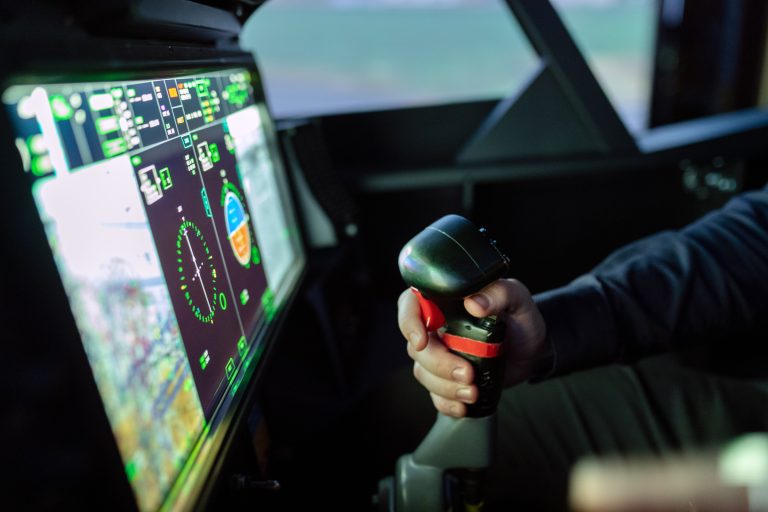Published on: April 3, 2023 Updated on: January 25, 2024
AI Simulation: Artificial Worlds With Real Impact
Author: Christina Muir

A survey by PWC found that 96% of participants were planning on using artificial intelligence (AI) simulation in 2022. But what even is AI simulation, and why do so many people want to use it?
You probably already have a basic understanding of AI and simulation, but combining them is a whole new concept not many know about.
Continue reading this article to hop on the fast train to innovation city before everyone else does. You’ll be glad that you did the extra research when it becomes the hottest topic of conversation.
What is the real difference between AI and simulation?
It’s not a stupid question; simulation software and artificial intelligence have some similarities. They both mimic something actually real. Other than that, simulation is quite different from aritficial intelligence altogether, primarily in the way that they are used.
Simulation is a computer system programmed to accurately imitate an environment, event, or process in the real world.
Within these special systems, models are used to create characteristics and behaviors responsible for accurate reproduction.
For example, if you are watching a simulation of a car going over a speed bump, the models will refer to their huge amounts of data regarding the car, the speed bump, and the environmental factors at play, e.g., speed and gradient, to create an accurate imitation.
Simulation can be used in many other ways, including entertainment, engineering, and business risk analysis.
You can simulate almost anything as long as it has a chain of events with fluctuating variables and inputs. If you think back to the car and the speed bump, the model of the car, the speed, or the height of the speed bump could all change instantly, and the simulation can still create an accurate scenario.
The first instance of simulation was created in 1947 in the form of a video game starring a simulated missile being shot into a target. Since then, this technology has evolved into something almost unrecognizable.
Simulation and digital twins
Now that you better understand this subject, we thought it was time to complicate things a little bit further.
To really get the full picture of what AI simulation is capable of, we introduce ‘digital twins’.
Digital twins are not two identical robots; it is a technology that uses data in real time to run multiple simulation environments at once.
AI can be used to increase the efficiency of digital twins by predicting the future and quickly deciding which tests are best to run depending on the data it collects.
Put simply; simulations let you see what might happen if it were real life, whereas digital twins show you what might happen alongside the current, real event.
Digital twins were first used by NASA in the 1960s to aid in Apollo 13. The technology was used to create a ground-level replica or ‘digital twin’ of every spacecraft up in space.
By having these replicas, engineers were able to adjust the simulations and troubleshoot the issues that the real spacecraft was experiencing via the digital twin.
If it wasn’t for digital twins, those brave astronauts on the Apollo 13 mission might have never made it home.
AI simulation and machine learning
Machine learning is a subset of AI and uses mathematical equations and algorithms to recognize patterns and predict outcomes to enhance decision making. It’s supposed to replicate human intelligence processes.
The data programmed into machine learning systems is known as training data and can be supervised, semi-supervised, unsupervised, or reward-based. These terms refer to the amount of human intervention involved in getting the correct output from the computer system.
To venture deeper, it is worth talking about deep learning techniques – a subset of machine learning. Also referred to as deep artificial neural networks, it is a system that uses big algorithms to continually improve itself.
Deep learning is inspired by the human being and the human brain in how it functions. Like how we trial and error to get better at things, the neural networks within deep learning do the same.
But what do these subsets have to do with AI technology and AI simulation?
Well, machine learning is what helps bridge the gap between AI and simulation. Machine learning provides advanced capabilities in finding parameters and automatically identifying repeat patterns, increasing speed and accuracy.
For machine learning models to operate, they need enormous computational resources. But simulation models can take care of this issue by artificially creating ‘synthetic data’ instead.
How synthetic data enhances artificial intelligence
The key to how simulation gives AI such a leg up is synthetic data. It is capable of speeding up processing and training, more variation in datasets, and protecting sensitive information.
Let’s have a closer look at these 3 main advantages of synthetic data as seen in AI:
Increased speeds
AI models love synthetic data because it comes with labels already assigned. This means that less time is used for processing, and humans don’t need to spend a huge portion of their time manually labeling data for the system to understand.
As well as increasing processing and training times, having synthetic data take care of the labeling saves money.
Variation in datasets
A dataset is a collection of information programmed into a system before it is given the all-clear to function in real world scenarios.
In a dataset are parameters, a minimum and a maximum, a 0 to 100, for example. Any data that the computer system comes across that lies within these parameters will be fully understood. If not, then it is not accounted for because, as far as the computer is concerned – it doesn’t exist. But, synthetic data can fill in these missing pieces.
Protects sensitive data
Data is valuable because it holds sensitive, personal information about users; this makes it legally unfeasible to analyze, share, or publish. But, this is where synthetic data saves the day as it does not hold any such private information and can be shouted from the rooftops without any ethical or legal repercussions.
When AI and simulation combine
When AI and simulation come together, magical things happen.
With AI’s machine learning algorithms, the most accurate simulations can be achieved by pulling relevant information from its huge data set. This holds lots of knowledge from previous computer system experiences, which continues to grow as it learns.
Not only can it pull the best possible data to execute an accurate recreation, but AI can also use this same machine learning to utilize the best processing system for the job.
In certain formats, these complex systems can have full automation for those who do not have the computer expertise to program it themselves. This is an excellent tool for those in research or other areas where accurate visual data is required.
AI simulation can also help these researchers find out what to study and the best way to do it.
This is due to the implemented machine learning optimizing the data which the researcher accesses, creating smaller pools of relevant information and allowing for faster, more accurate recall.
A particular mathematical strategy called Bayesian Optimization can use the knowledge it already has to understand and predict unknown data. AI takes care of this function and makes the whole simulation much faster at processing information.
AI simulation use cases
As per the digital twins and NASA, AI simulation is continually applied in engineering. Workflow in the research and development area can be dramatically reduced with the introduction of AI methodologies to optimize the design process.
Standard engineering simulations are just not as quick or accurate as they could be. The connection between variables and test results is learned from and applied to a much bigger understanding of the overall engineering network.
I know it sounds confusing. Essentially, AI simulation = faster engineering research, development, and testing = happy humans.
Another common industry where AI simulation is used is self-driving/autonomous cars. By utilizing these complex systems, cars can navigate roads, pedestrians, and even roundabouts without human intervention.
Simulation methods and AI can also be used to communicate with one another, which in turn reduces congestion. This functions through a 3D visualization of the surrounding area, mapping real time navigation to deliver the perception of the environment, highly accurate location, and data-driven decision making.
Another use case example is a little bit less exciting but still very innovative – sales forecasting.
With the high performance of artificial intelligence, thousands upon thousands of criteria are measured continuously. Previous sales, customer experience reviews, engagement, and conversion rates will give the simulation platform the exact data it needs to actually forecast sales.
Once all of this information is collected and measured, the combination of machine learning and AI will break it down and begin to make connections. As well as predicting sales, this information is incredibly valuable for marketing managers and sales teams to adapt future business strategies.
Where will AI simulation go next?
We can thank big data for doing the heavy lifting, but synthetic data, historical data and machine learning were the ones to pave the way to something incredible – AI simulation.
Digital twins all the way back in 1960 were already incredible, but seeing how seamlessly AI and simulation have fused together to drive our cars, predict our sales, and optimize our engineering workflow is becoming part of the norm.
A feat in data science, AI simulation has continued to wow us and really blur the lines between what is happening and what could happen. We no longer have to worry about the unknown; it can be laid out right in front of us if we want it to be.
So, the final question to ask is, where will intelligent systems go next?
It will likely be used as a prediction tool well into the future and give us the power to visualize things that we could otherwise barely imagine.
It could become so realistic that we could be in one and not realize it…
Did you know that artificial intelligence and simulation could create something so magical? To understand how technology got this far, read more at Top Apps.
Christina Muir
Christina's expertise in the tech industry allows her to provide insightful and informative content to her readers, covering a range of topics from productivity and lifestyle apps to gaming and entertainment software.
Recent Articles

Learn how to use advanced search tools, newsletters, and reviews to uncover the perfect AI-focused podcast for you.
Read More
Explore the top beginner-friendly AI podcasts. Our guide helps non-techies dive into AI with easy-to-understand, engaging content. AI expertise starts here!
Read More
Explore the features of The AI Podcast and other noteworthy recommendations to kick your AI learning journey up a notch. AI podcasts won’t...
Read More